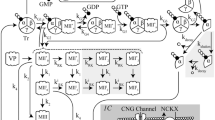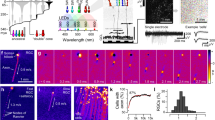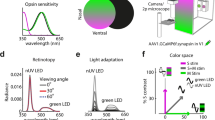Abstract
Electrical responses of cone photoreceptors in the retina of the freshwater turtle have been characterised for flashes and steps of light in darkness and in the presence of background light1–4. These intracellular measurements have been combined with the behavioural increment threshold curve to yield an estimate of 5–10 µV for the signal developed in a cone when the turtle can just detect an increment flash5. The signal developed when the cones under the stimulus image are dark-adapted is of interest, for its measurement would help to explain how known physiological processes subserve visual detection for a variety of photic conditions. The effective quantal absorption of dark-adapted, red-sensitive cones of Pseudemys scripta elegans for a stimulus that the turtle can just detect is reported here. By combining this result with previous electrical measurements on red-sensitive cones of this species, an estimate of 35–70 µV is obtained for the signal developed in a dark-adapted cone at behavioural threshold. This larger signal required for detection of a flash in darkness is of particular interest in view of the recent observation6 that the intrinsic noise of turtle cones in darkness is larger than that of illuminated cones.
This is a preview of subscription content, access via your institution
Access options
Subscribe to this journal
Receive 51 print issues and online access
$199.00 per year
only $3.90 per issue
Buy this article
- Purchase on Springer Link
- Instant access to full article PDF
Prices may be subject to local taxes which are calculated during checkout
Similar content being viewed by others
References
Granda, A. M. & Dvorak, C. A. in Handbook of Sensory Physiology, vol VII/5 (ed Crescitelh, F.) 451–495 (Springer, Berlin, 1977).
Baylor, D. A. & Hodgkin, A. L. J. Physiol., Lond. 234, 163–198 (1973).
Baylor, D. A. & Hodgkin, A. L. J. Physiol., Lond. 242, 729–758 (1974).
Baylor, D. A., Hodgkin, A. L. & Lamb, T. D. J. Physiol., Lond. 242, 685–727 (1974).
Fain, G. L., Granda, A. M. & Maxwell, J. H. Nature 265, 181–183 (1977).
Simon, E. J., Lamb, T. D. & Hodgkin, A. L. Nature 256, 661–662 (1975).
Maxwell, J. H. & Granda, A. M. Physiol. Behav. 15, 131–132 (1975).
Born, M. & Wolf, E. Principles of Optics, 188 (Pergamon, New York, 1965).
Bowling, D. B. thesis, Univ Colorado (1976).
Brown, K. T. Vision Res. 9, 1053–1062 (1969).
Baylor, D. A. & Fettipiace, R. J. Physiol., Lond. 248, 433–464 (1975).
Lamb, T. D. & Simon, E. J. J. Physiol., Lond. 263, 257–286 (1976).
Author information
Authors and Affiliations
Rights and permissions
About this article
Cite this article
Dvorak, C., Granda, A. & Maxwell, J. Photoreceptor signals at visual threshold. Nature 283, 860–861 (1980). https://doi.org/10.1038/283860a0
Received:
Accepted:
Issue Date:
DOI: https://doi.org/10.1038/283860a0
Comments
By submitting a comment you agree to abide by our Terms and Community Guidelines. If you find something abusive or that does not comply with our terms or guidelines please flag it as inappropriate.



